深度学习——猴痘病识别
- 🍨 本文为🔗365天深度学习训练营 中的学习记录博客
- 🍖 原作者:K同学啊 | 接辅导、项目定制
- 🚀 文章来源:K同学的学习圈子
一、前期准备工作
1、设置GPU
from tensorflow import keras
from tensorflow.keras import layers,models
import os,PIL,pathlib
import matplotlib.pyplot as plt
import tensorflow as tf
gpus=tf.config.list_physical_devices("GPU")
if gpus:
gpus0=gpus[0]
tf.config.experimental.set_memory_growth(gpus0,True)
tf.config.set_visible_devices([gpus0],"GPU")
gpus
2、导入数据
data_dir="D:\桌面\深度学习数据\第4周"
data_dir=pathlib.Path(data_dir)
3、查看数据
image_count = len(list(data_dir.glob('*/*.jpg')))
print("图片总数为:",image_count)

查看病毒数据集的第一张数据图片
Monkeypox = list(data_dir.glob('Monkeypox/*.jpg'))
PIL.Image.open(str(Monkeypox[0]))
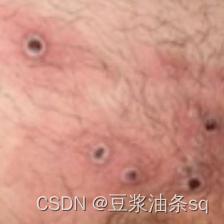
二、数据预处理
1、加载数据
使用image_dataset_from_directory方法将磁盘中的数据加载到tf.data.Dataset中
测试集与验证集的关系:
1.验证集并没有参与训练过程梯度下降过程的,狭义上来讲是没有参与模型的参数训练更新的。
2.但是广义上来讲,验证集存在的意义确实参与了一个“人工调参”的过程,我们根据每一个epoch训练之后模型在valid data上的表现来决定是否需要训练进行early stop,或者根据这个过程模型的性能变化来调整模型的超参数,如学习率,batch_size等等。
3.因此也可以认为,验证集也参与了训练,但是并没有使得模型去overfit验证集
batch_size = 32
img_height = 224
img_width = 224
train_ds = tf.keras.preprocessing.image_dataset_from_directory(
data_dir,
validation_split=0.2,
subset="training",
seed=123,
image_size=(img_height, img_width),
batch_size=batch_size)
val_ds = tf.keras.preprocessing.image_dataset_from_directory(
data_dir,
validation_split=0.2,
subset="validation",
seed=123,
image_size=(img_height, img_width),
batch_size=batch_size)
通过class_names输出数据集的标签。标签将按字母顺序对应于目录名称
class_names = train_ds.class_names
print(class_names)
2、可视化数据
plt.figure(figsize=(20, 10))
for images, labels in train_ds.take(1):
for i in range(20):
ax = plt.subplot(5, 10, i + 1)
plt.imshow(images[i].numpy().astype("uint8"))
plt.title(class_names[labels[i]])
plt.axis("off")

3、再次检查数据
for image_batch, labels_batch in train_ds:
print(image_batch.shape)
print(labels_batch.shape)
break
- Image_batch是形状的张量(32,180,180,3)。这是一批形状180x180x3的32张图片(最后一维指的是彩色通道RGB)。
- Label_batch是形状(32,)的张量,这些标签对应32张图片
4、配置数据集
- huffle() :打乱数据
- prefetch() :预取数据,加速运行
prefetch()功能详细介绍:CPU 正在准备数据时,加速器处于空闲状态。
相反,当加速器正在训练模型时,CPU 处于空闲状态。
因此,训练所用的时间是 CPU 预处理时间和加速器训练时间的总和。
prefetch()将训练步骤的预处理和模型执行过程重叠到一起。当加速器正在执行第 N 个训练步时,CPU 正在准备第 N+1 步的数据。这样做不仅可以最大限度地缩短训练的单步用时(而不是总用时),而且可以缩短提取和转换数据所需的时间。
如果不使用prefetch(),CPU 和 GPU/TPU 在大部分时间都处于空闲状态:

使用prefetch()可显著减少空闲时间:

- cache() :将数据集缓存到内存当中,加速运行
AUTOTUNE = tf.data.AUTOTUNE
train_ds = train_ds.cache().shuffle(1000).prefetch(buffer_size=AUTOTUNE)
val_ds = val_ds.cache().prefetch(buffer_size=AUTOTUNE)
三、构建CNN网络
卷积神经网络(CNN)的输入是张量 (Tensor) 形式的 (image_height, image_width, color_channels),包含了图像高度、宽度及颜色信息。
不需要输入batch size。
color_channels 为 (R,G,B) 分别对应 RGB 的三个颜色通道(color channel)。
在此示例中,CNN 输入的形状是 (224, 224, 4)即彩色图像。需要在声明第一层时将形状赋值给参数input_shape。
网络结构构图:
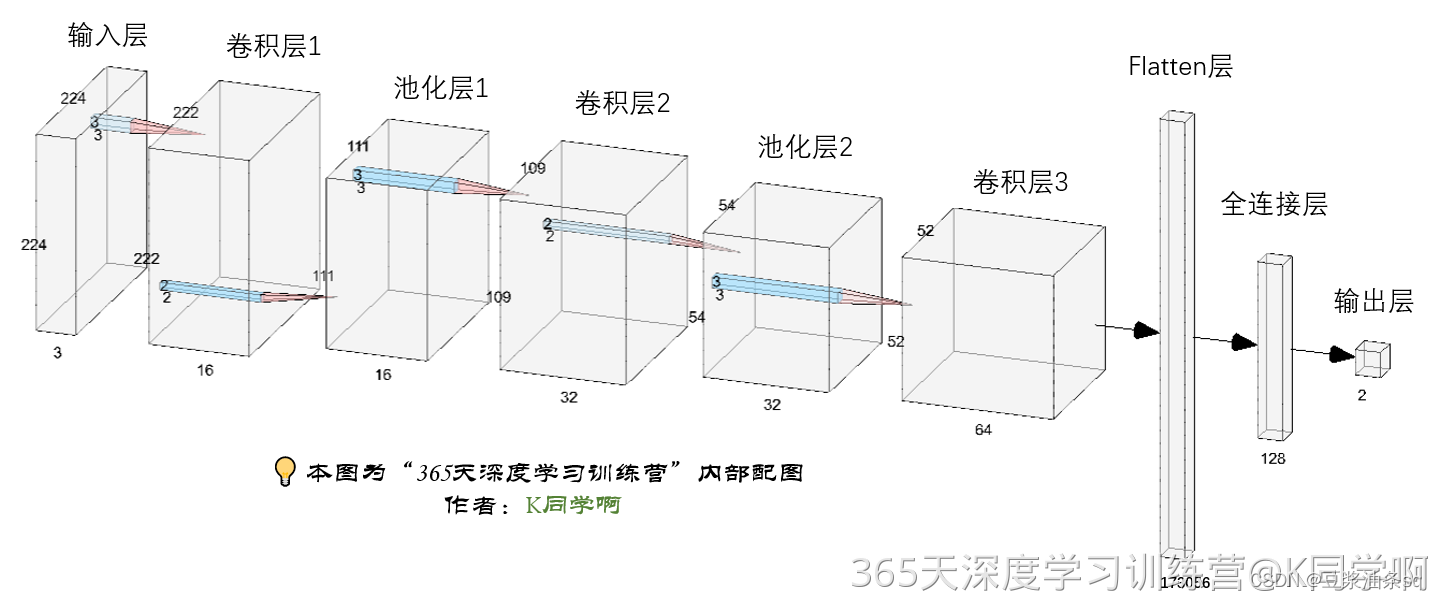
num_classes = 2
model = models.Sequential([
layers.experimental.preprocessing.Rescaling(1./255, input_shape=(img_height, img_width, 3)),
layers.Conv2D(16, (3, 3), activation='relu', input_shape=(img_height, img_width, 3)), # 卷积层1,卷积核3*3
layers.AveragePooling2D((2, 2)), # 池化层1,2*2采样
layers.Conv2D(32, (3, 3), activation='relu'), # 卷积层2,卷积核3*3
layers.AveragePooling2D((2, 2)), # 池化层2,2*2采样
layers.Dropout(0.3),
layers.Conv2D(64, (3, 3), activation='relu'), # 卷积层3,卷积核3*3
layers.Dropout(0.3),
layers.Flatten(), # Flatten层,连接卷积层与全连接层
layers.Dense(128, activation='relu'), # 全连接层,特征进一步提取
layers.Dense(num_classes) # 输出层,输出预期结果
])
model.summary() # 打印网络结构
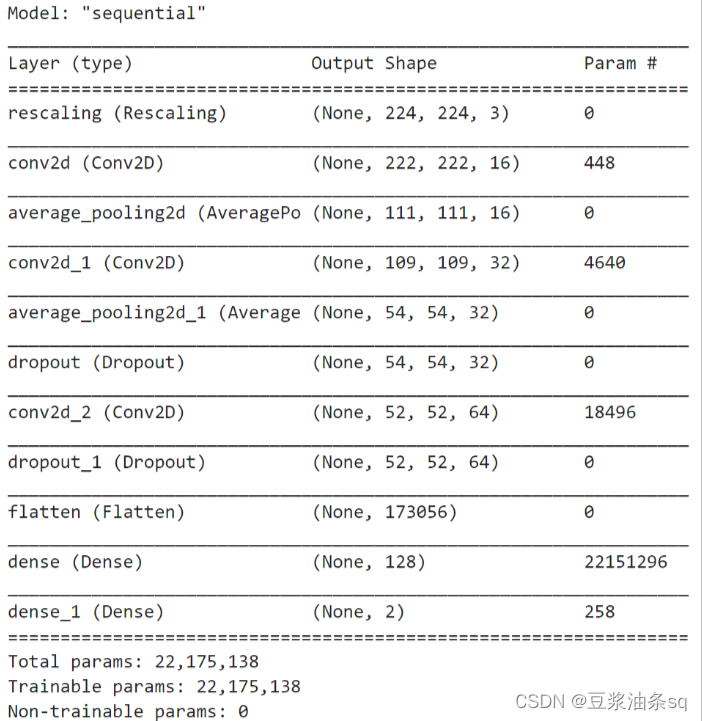
四、编译
- 损失函数(loss):用于衡量模型在训练期间的准确率。
- 优化器(optimizer):决定模型如何根据其看到的数据和自身的损失函数进行更新。
- 指标(metrics):用于监控训练和测试步骤。以下示例使用了准确率,即被正确分类的图像的比率。
# 设置优化器
opt = tf.keras.optimizers.Adam(learning_rate=1e-4)
model.compile(optimizer=opt,loss=tf.keras.losses.SparseCategoricalCrossentropy(from_logits=True),metrics=['accuracy'])
五、训练模型
from tensorflow.keras.callbacks import ModelCheckpoint
epochs = 50
checkpointer = ModelCheckpoint('best_model.h5',
monitor='val_accuracy',
verbose=1,
save_best_only=True,
save_weights_only=True)
history = model.fit(train_ds,
validation_data=val_ds,
epochs=epochs,
callbacks=[checkpointer])
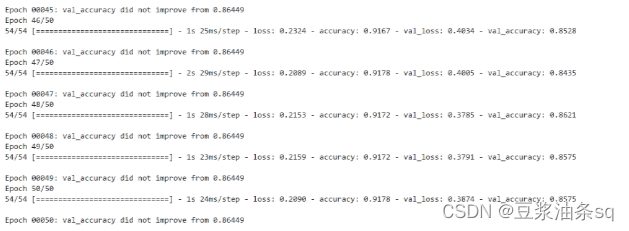
六、模型评估
1、Loss与Accuracy图
acc = history.history['accuracy']
val_acc = history.history['val_accuracy']
loss = history.history['loss']
val_loss = history.history['val_loss']
epochs_range = range(epochs)
plt.figure(figsize=(12, 4))
plt.subplot(1, 2, 1)
plt.plot(epochs_range, acc, label='Training Accuracy')
plt.plot(epochs_range, val_acc, label='Validation Accuracy')
plt.legend(loc='lower right')
plt.title('Training and Validation Accuracy')
plt.subplot(1, 2, 2)
plt.plot(epochs_range, loss, label='Training Loss')
plt.plot(epochs_range, val_loss, label='Validation Loss')
plt.legend(loc='upper right')
plt.title('Training and Validation Loss')
plt.show()
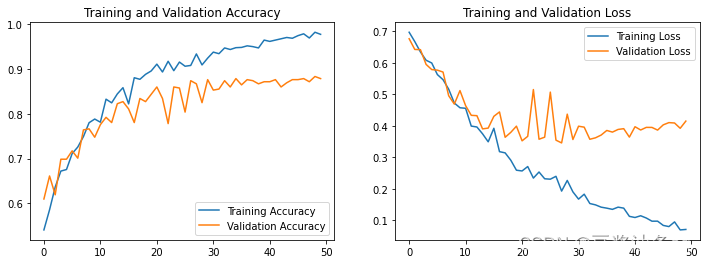
2、指定图片进行预测
# 加载效果最好的模型权重
model.load_weights('best_model.h5')
from PIL import Image
import numpy as np
img = Image.open("MonkeyData/Monkeypox/M06_01_04.jpg") #这里选择需要预测的图片
# img = Image.open("MonkeyData/Others/NM15_02_11.jpg") #这里选择需要预测的图片
image = tf.image.resize(img, [img_height, img_width])
img_array = tf.expand_dims(image, 0)
predictions = model.predict(img_array) # 这里选用已经训练好的模型
print("预测结果为:",class_names[np.argmax(predictions)])
预测结果为:Others







 本文详细介绍了在365天深度学习训练营中,作者K同学通过TensorFlow构建和训练一个CNN模型,用于猴痘病图片的识别。内容包括GPU设置、数据加载与预处理、构建CNN网络、编译、训练模型、模型评估以及预测特定图片的结果。
本文详细介绍了在365天深度学习训练营中,作者K同学通过TensorFlow构建和训练一个CNN模型,用于猴痘病图片的识别。内容包括GPU设置、数据加载与预处理、构建CNN网络、编译、训练模型、模型评估以及预测特定图片的结果。














 1293
1293

 被折叠的 条评论
为什么被折叠?
被折叠的 条评论
为什么被折叠?








